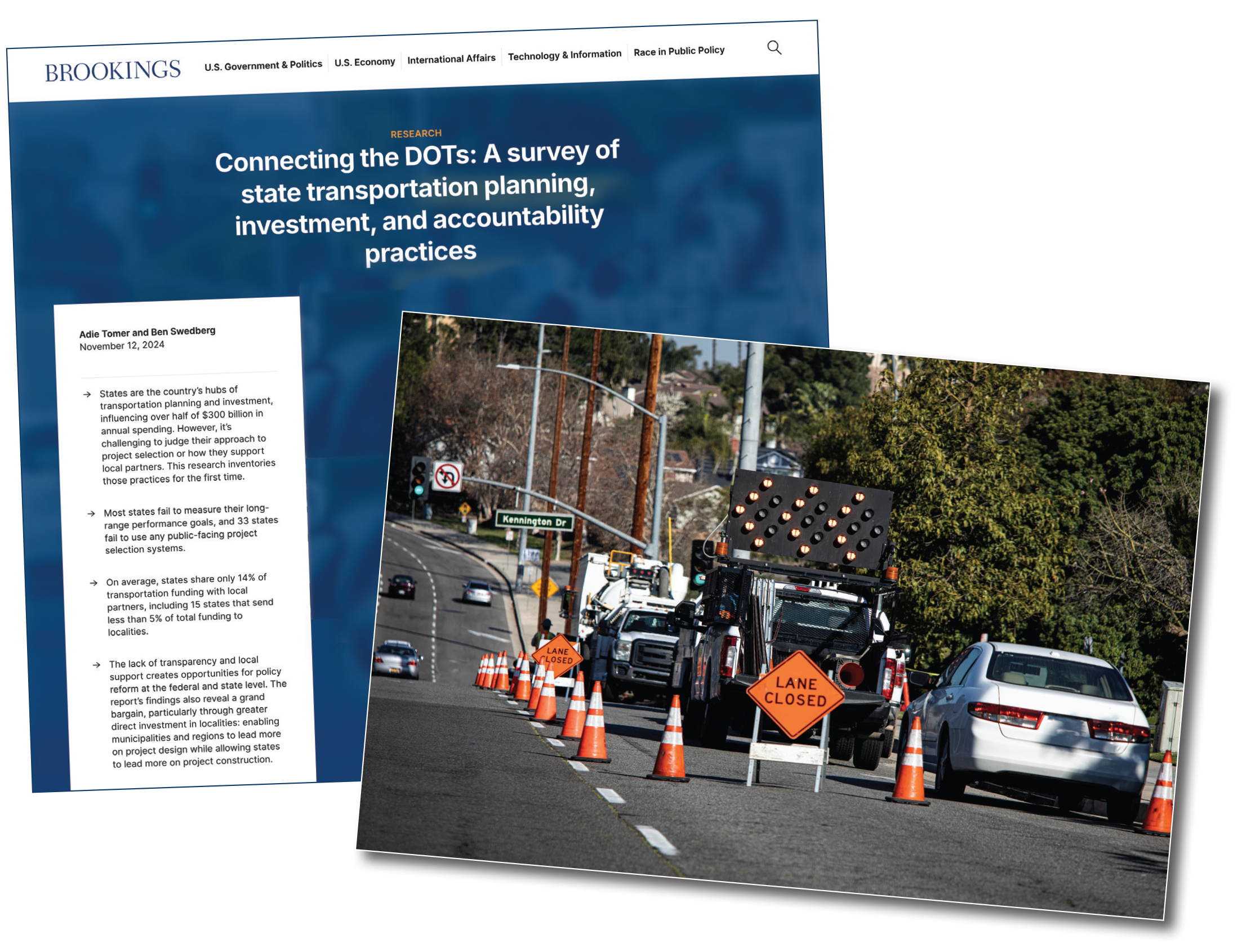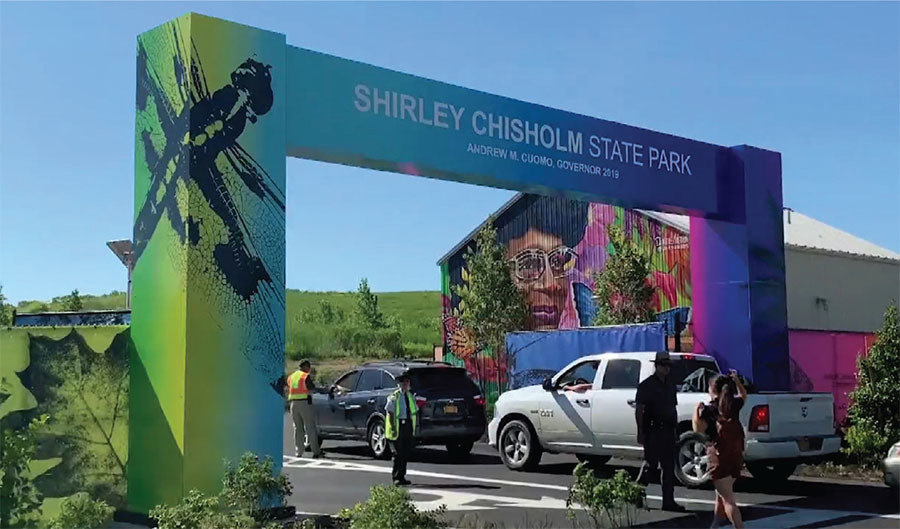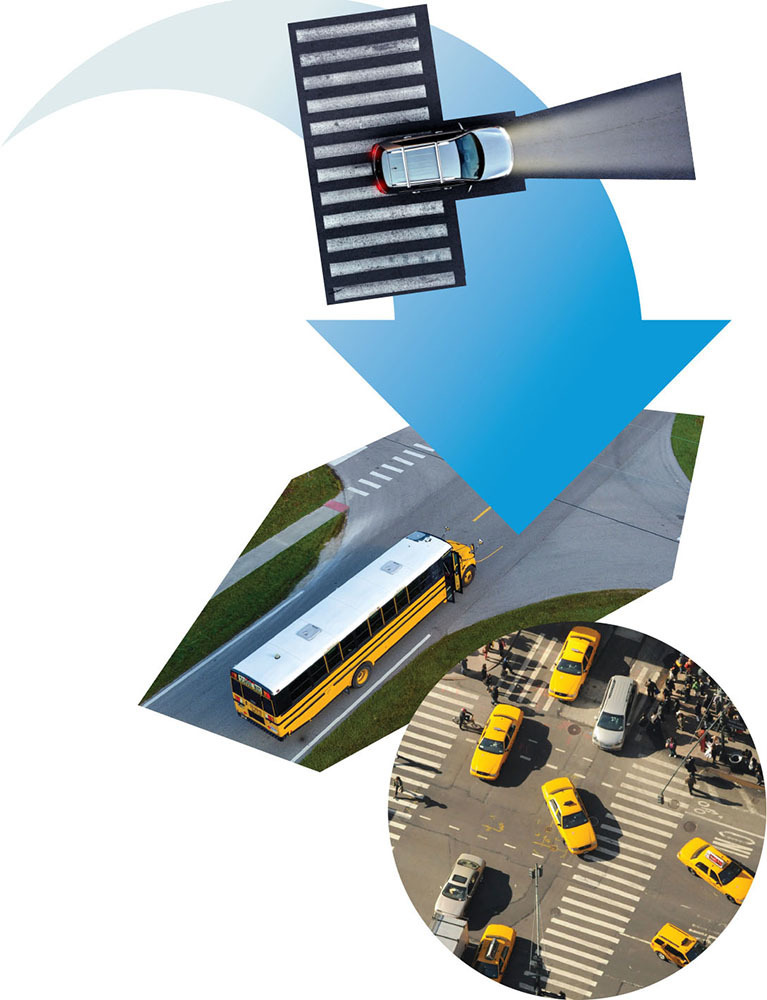July/August 2019
Communities: Government
Goodbye, Parking Garages. Hello, Dedicated Driverless Lanes.
BY DAVE ZELENOK, P.E. AND GEORGE WENTZ, P.E.
 DAVE ZELENOK, P.E.
DAVE ZELENOK, P.E. GEORGE WENTZ, P.E.
GEORGE WENTZ, P.E.Transportation technologies are evolving at an unprecedented pace, and will have profound effects. Engineers and public officials must start preparing today for an inevitable, vastly different future.
“Big data,” high-speed communications, and transportation options such as autonomous vehicles and micro-transit are just a few disruptive technologies that will affect how we live, work, and play.
Although the primary impacts of these changes are becoming better understood, the secondary consequences have been largely uncharted. Facing the largest modal shift seen since the invention of the automobile, the engineering profession will be challenged to change the ways in which we plan and develop our future roads, parking, transportation networks, and entire urban fabric.
New Levels of Communicating
For the past decade, industry has been researching and testing vehicles that can sense the environment around them and communicate with other vehicles and infrastructure. The key to vehicle-to-vehicle (V2V) and vehicle-to-infrastructure (V2I) communications is a robust communications network—which is still lacking.
While fiber-optic-based telecommunications are highly regarded for their speed (megabytes downloaded per second) and reliability, their real value will come from their near-zero latency, or ability to communicate in virtual real-time with the networks.
Vehicles “platooning” in tightly spaced and interconnected groups will require the ability to locate themselves and others to an accuracy of less than three centimeters. This will require vehicles moving at 60 mph to communicate with their networks in less than one millisecond.
Initially, fiber optic backbones won’t be available everywhere, but neither will the infrastructure to support these connected platoons. As our communities become “smart cities,” our telecommunication systems will be expanded, repurposed, and readapted for many parts of our daily lives, including transportation.
“Big Data” and Transportation Technologies
Once our communication networks are up to par, what’s next? Soon “totally managed systems,” interconnected systems often using big data, will be able to reduce accidents and congestion by predicting and avoiding traffic jams—changing traffic routes, speeds, and signal coordination in time to harmonize traffic flows.
AVs driving in platoons mere inches from each other may also reduce traffic congestion. Car ownership will likely decrease as people opt for different modes of transportation. These modal shifts will all drive changes in the ways that we develop our infrastructure.
Which future transportation technologies are showing the most promise?
- Autonomous vehicles. Think Teslas, with steering wheels. (Here today)
- Personal rapid transit systems. Driverless low-cost-per-mile vehicles on fixed guideways or dedicated street networks. Great in certain urban settings. (Here today)
- “Scootermania.” Shared, hyperlocal, microtransportation providing “last-half-mile” trips. (Here today, often lacking regulation)
- Driverless cars. Vehicles without steering wheels. (Perhaps beginning in about five years; may be the norm by about 2040)
- Transportation as a service. Purchase only the transportation you need; car ownership, driveways, wide streets, and three-car garages become unnecessary. (Coming soon)
- Pilotless aerial vehicles. Vertical take-off and landing (VTOL) flying taxis could take a while as public policies on noise, overflights, and approach patterns catch up. (Maybe post-2050)
What’s the impact on our infrastructure? More congestion initially, until totally managed systems are deployed. Some estimates indicate capacity increases of 300% may be realized by compressing the distance between vehicles.*
Increased capacity, created by compressed platoons of interconnected smart vehicles running at optimum lane capacity, may be the most positive disruption occurring by 2040. This seemingly innocuous change may eliminate the need for many of the road-widening or capacity-enhancement projects now on the books of our metropolitan planning organizations.
The beginning of the end of many road-widening projects may happen sooner than you can imagine. And that could, in turn, reduce the need for infrastructure spending nationally by trillions, leading to an unprecedented “infrastructure/technology dividend.”
Questions and Answers
Q: What kinds of infrastructure are we now building that will become obsolete and why?
A: To name a few…
- Parking garages. Cars will park themselves. The density of cars in structures will increase, since driverless cars will discharge passengers before entering the structure and can park inches apart—no need to open doors. Plan now to repurpose your garages in 20 years. Redesign them with higher ceilings and flat, not sloped, surfaces to repurpose them into retail or residential structures when the demand drops.
- Road-widening projects. If efficiency of many of our roadways goes up, why do we need to plan for widening beyond 2040?
- Mass transit as we know it. Inter-connected driverless cars will behave as trains or buses. So, will the mass transit “death spiral” many systems are now in continue?
- Traffic signals. Analog control (i.e., red lights) will be placed in the hands of automated systems and, eventually, traffic signals themselves may become obsolete.
Q: What kinds of infrastructure are we not building now that we need to plan for today?
A: Infrastructure such as…
- Dedicated driverless lanes;
- Fiber-optic-based near-zero latency roadside telecommunications;
- Totally managed infrastructure control systems to accommodate pedestrians, horses and buggies, Oldsmobiles, autonomous and driverless vehicles—all simultaneously;
- Real-time measurements of pavement skid resistance to slow or stop interconnected vehicles and platoons. One highly promising system may be fiber as a sensor—using fiber optic strands to detect minuscule variations in pavement conditions, including vehicle weights, direction, and velocities.
Q: What else don’t we know?
A: Will people riding to work (and working in their driverless cars) begin living farther away, triggering a new wave of urban sprawl?
Q: Is there a single common element that smart cities have?
A: Advanced fiber-optic-based telecommunications is critical. The cost of a single fiber-optic strand can be as little as one cent per linear foot, but the cost to install cables later can be as high as $60 per foot.
It is critical for public works managers to seize every opportunity to install fiber optic cables during street construction or upgrades to utility meters or traffic signals. Better yet, excess capacity of fiber optic cables can often be leased or sold to generate revenue. Similar to creating strategic master plans for roads, sanitary services, or stormwater, community leaders need to create intelligent transportation systems and fiber master plans to help them become fiber-dense to accommodate future communication demands.
Q: What’s the one most important thing a public agency needs to advance smart city approaches?
A: An internal, senior-level champion. Without high-level public officials’ advocacy and understanding of the benefits of smart city solutions, advancing these initiatives can be difficult. Public works officials should use every opportunity to educate their senior managers and elected officials on the topic.
The need for this infrastructure will skyrocket in the coming years. Public agencies that position themselves now for this inevitable tsunami of smart city applications will find themselves years ahead of the curve. Best of all, with careful planning, many cities are finding innovative ways to make the needed infrastructure self-funding and even revenue-generating.
Q: How do we start the ball rolling?
A: First, seek professional expertise to help create a vision for developing your smart city. Second, execute smaller-scale projects to get “easy wins” and demonstrate their value. Finally, highlight the value and results to your elected officials and the public to build awareness and support.
Public officials must start changing how they’re planning for our nation’s infrastructure. Designing and investing in our highways, traffic control networks, mass transit systems, and intermodal facilities must all be done differently. Now is the time for community leaders to evolve transportation planning for our rapidly changing future.
Dave Zelenok, P.E., is the manager of local government services for HR Green Inc., where he consults with public agencies and the private sector on smart city technologies, innovation processes, transportation infrastructure, and public-private partnerships; [email protected]. George Wentz, P.E., serves as vice president of HR Green’s Governmental Services Business Line, which helps local agencies function more effectively and efficiently; [email protected].
*300% Capacity Increase—Really?
Traffic engineers often estimate the best flow rate today allows about 2200 vehicles per hour to use a single lane at an optimum speed of about 44–50 mph.
That assumption means about 36 twenty-foot-long vehicles can use that lane per minute, amounting to about 720 “feet of vehicles” per mile per minute.
Assuming that estimate is correct, there’s (5280 - 720, or) about 4560 feet of “empty pavement” under optimum conditions. In other words, only about 15% of the pavement is “occupied” at any moment. That is, the best efficiency today is about 15% used, or 85% “empty” infrastructure under ideal conditions.
To achieve a 300% increase in capacity, these V2V and V2I systems need only compress these platoons to about half the current bumper-to-bumper distance, and consequently increase pavement “occupied” from 15% to about 45%, meaning that under these conditions our lanes will still be 55% “empty.”
Increasing the efficiency of even a single lane by this amount could reduce the need to widen adjacent lanes while achieving increased capacity.


 Volunteering at NSPE is a great opportunity to grow your professional network and connect with other leaders in the field.
Volunteering at NSPE is a great opportunity to grow your professional network and connect with other leaders in the field. The National Society of Professional Engineers (NSPE) encourages you to explore the resources to cast your vote on election day:
The National Society of Professional Engineers (NSPE) encourages you to explore the resources to cast your vote on election day:




